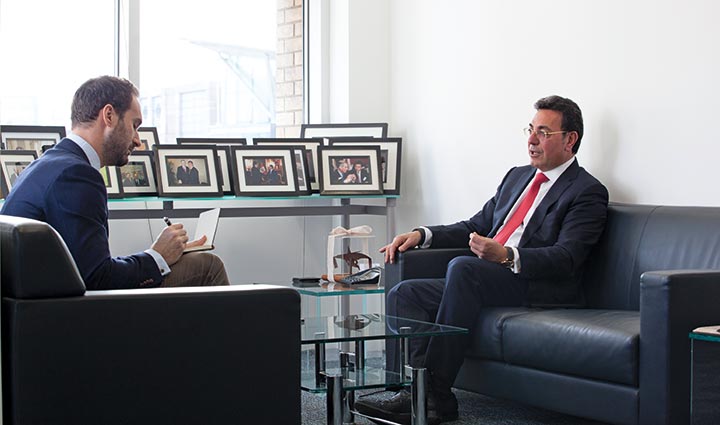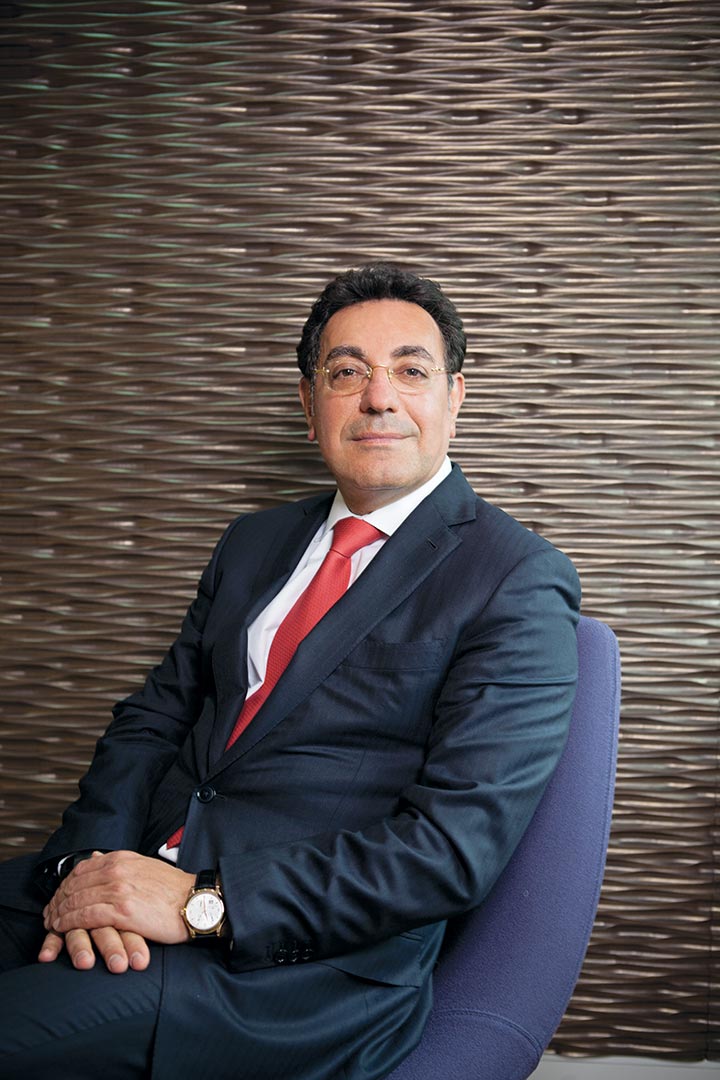WRITER: Nicolas Shammas PHOTOGRAPHER: David Woolfall
In terms of leadership, Samir Brikho is a phenomenon. He has a style that’s not solely driven by results – though it certainly produces them – rather his influence is rooted in the passion he has for his work and his ability to inspire those around him to reach ever-higher goals.
When it comes to Arab titans of business, we’re all familiar with the Ghosns, Slims and Hayeks of this world. I would assume you’re also aware of others like Lubna Olayan and Nemir Kirdar. You may even know that Steve Jobs is among our greats given that he was the biological son of a Syrian emigrant, Abdul Fattah Jandali. But chances are you’ve never heard of Samir Brikho. It’s a shame that, because if you were to judge him based on his performance as a chief executive, he deserves to be up there with the very best of them.
Of course, unlike watches, consumer electronics, telecoms or finance, many might struggle to understand what Brikho’s company, Amec Foster Wheeler, actually does. (It’s one of the world’s leading international engineering services companies and one of the U.K’s oldest and most respected publically listed firms.) Brikho has been at the helm since 2006 and, in that time, he has so successfully transformed its ailing performance that he’s now the subject of case studies at the prestigious INSEAD business school.
“I joined Amec about eight and a half years ago, in October 2006. The board had been looking for a CEO that could bring a new vision, a new strategy, set up new values and create a new culture,” says Brikho as we sit and chat in his company headquarters in London, surrounded by photos of him with leading global figures like Bill Clinton, David Cameron, Kofi Annan, Yasser Arafat, Shimon Peres and Nicolas Sarkozy. Though this could be misconstrued as a little self-aggrandising, Brikho explains that the collection of portraits is actually “just a bit of fun” and a pet project by him and his assistant that may have gotten a little out of hand, before bursting into an infectious laugh.
Born in Beirut in 1958, Brikho was raised in Sweden where he and his family had fled at the onset of the Lebanese civil war. There he remained for his undergraduate and postgraduate degrees, which were in mechanical engineering and thermal technologies respectively (with additional studies in nuclear and renewable energy). Sweden is also where he first began his career with ABB, who hired him straight out of university, although he later moved to their headquarters in Switzerland. Starting out in their power generation division, he worked his way up until he ran that particular business – even after it was acquired by Alstom – and later returned to ABB to head up their oil and gas division.
“When the board of Amec hired me, they knew they were getting a hybrid, someone who had both power, and oil and gas experience, and there aren’t many of us around,” explains Brikho. “But more than that, I had made a name at ABB for being a good leader and someone who had been responsible for a number of transformations, and that’s what the mission was here. They wanted to transform Amec so they needed someone who could rock the boat. When I joined, the company’s margins were only around 3.5 per cent, and the board’s aspiration was that the new management team increase them to 4.5 per cent. 73 days later, I presented Vision 2010 to the market and this laid out our ambition to take the company’s margins to 6 per cent by 2008 and 8 per cent by 2010. What we delivered at the end of the day was 9.2 per cent by 2010. To be honest, I think even the board was surprised by the speed with which we were able to understand what were the main issues and possible remedies.”
Patently, Brikho was the right man for the job but the question is, how did he do it? He credits activity-based-cost (ABC) modelling, which allowed him to examine each of this 132-year old company’s 40 business activities in their own right, and says that it took just 60 days for a revealing picture to emerge, one that showed which businesses could be considered core. “A core business is a business where you have the right skills, the right talents, the right customer relations, an offering that’s differentiated from your peers, and somewhere you continuously make money,” he explains.
In the end, only eleven of the 40 sectors fell into that criteria, a conclusion that must have seemed almost sacrilegious for many inside the company. “I was cognizant of the fact I was an outsider. Of course, you cannot just come up to the employees and say we are going to sell 29 of our businesses. How many people will be behind you? None. They will think you’re a lunatic with no grasp of the business. You have to take the emotions and the heat out of the discussion. It’s very important that a CEO has a high degree of engagement with his employees so that they can shape the future together. It must never be the vision of the CEO. It should be the vision of the company.”
As you might suspect, Brikho succeeded in winning over both management and the board and, just two months and a half after taking over the company, he sold off the non-core businesses so that Amec could focus on four sectors: oil and gas, clean energy, mining, and lastly, environment and infrastructure.
Naturally, a restructuring period came next, and a slimming down of Amec’s workforce from a previous high of 35,000 employees to just 17,000, which Brikho saw in a positive light, “We needed to reform the business into a fit, lean, efficient and effective one.” Still, his biggest problem had yet to be solved.

Amec was bleeding profits due to lingering legacy issues involving projects that had yet to be closed. “It took a change of philosophy to fix those: rather than having the best teams on the new jobs and the less good ones dealing with problems, I swapped that around. It was like having a cup with a hole in it and you’re trying to fill the cup. If the hole is bigger than the rate at which you’re filling, then you need to plug the hole, and fast. So I moved the company’s brightest and best and said, ‘You’re going to be recognised, remunerated and incentivised only on this.’ And within a year, we were able to solve most of our problems.”
Ironically, given the benefit of retrospect, not everyone had been convinced by Brikho’s first address to the market. The Financial Times for example, labelled his presentation as a “barnstorm” and “over-optimistic”. The market however, saw it differently, because for the next two years, Amec was one of Britain’s best performing stocks and one of the fastest moving companies on the FTSE. “We are a now a 10 billion USD business, which is more or less six times what we used to be when I started,” says Brikho in a deadpan manner, which surprisingly leaves little room for his words to be misconstrued as boastful. “Also today, we are making a profit of roughly seven times what we were doing in the past.”
Having transformed, consolidated and grown the company since 2006, last year Brikho went ahead with the acquisition of Foster Wheeler, a large US-listed global engineering firm, for approximately 3.3 billion USD, in a cash and equity deal. The merger would add a further 13,000 staff to Amec’s now 29,000-strong team, as well as midstream and downstream capabilities (meaning they are now one of the few firms in the world today capable of offering services across the whole value chain of the oil and gas business), and critically enlarge the firm’s geographic footprint into growth regions like the Middle East, Asia and Latin America, where Foster Wheeler had a strong presence.
Maybe it’s a bit of a paradox but this merger has brought Brikho back to where he started almost eight and a half years ago. “It’s true, I started as a transformer, continued as a grower then as a stabiliser, and now I am back to the role of a transformer.” One might wonder how, beyond the cost synergies, alignment of tools and processes, and harmonisation of the front end, he plans to transform the business a second time. But once again, he has a singularity of vision and the belief that it can only be by reshaping his most important asset.
“If you look at Amec Foster Wheeler in terms of the balance sheet, you’ll see that our whole fixed asset base is around 100 million USD. If you divide 100 million USD by 42,000 employees then you get an iPad, which goes to show that the most important asset in a company like ours, is the employees. This sounds like a cliché, but it’s the absolute truth. We are a services-based company after all. How are we able to deliver value to our customers? It’s through the employees. What is it we sell? We sell competence, brains, passion, knowledge, experience, adaptation, and innovative solutions. So it can only be through education and development that we can improve. Now the board will ask, if we invest 10 USD in an employee named John, can we get our 10 USD back? The reality is that we actually get back 20 or 30 USD. Is it good for John? Of course, because he’s now growing, he performs better, he gets better satisfaction from his work and he also ends up being more marketable so it’s a win-win position.”
As such, Brikho has set up what he calls the Amec Foster Wheeler Academy, a virtual and a physical programme that provides both online and face-to-face learning to almost every employee for further education, on an annual basis. By identifying each individual’s aspirations and potential, they help and support them achieve more in-depth knowledge that in turn aids the company in becoming stronger, more efficient and more innovative. Whether these are project management courses, engineering courses or even, as Brikho explains, foundation courses, every employee will go through the academy so as to add weapons to their individual arsenals.
It’s a well thought out long-term strategy that should reap considerable rewards in the future and to that effect, Brikho tells me, “Working at Amec Foster Wheeler is not about doing your work and going home, that’s simply not good enough. It’s a minimum. You need to do more.”
Brikho is a highly impressive man and he will, I am sure, one day be talked about in the same breath as the corporate greats. Never content with things as they are, he sees civilisation as a continuous progression towards improvement because “otherwise we would just remain as we were before. What we want, what we drive for, is to create a better world than the one that we have inherited.”
The world could certainly use a few more of his ilk.
